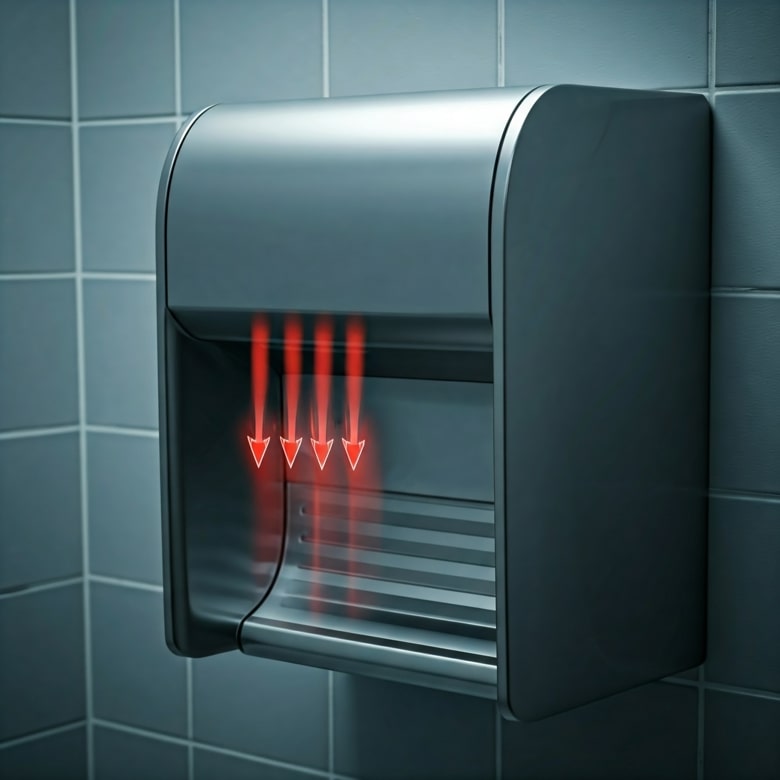Where Is the Heating Element in a Commercial Hand Dryer
Posted by Handy Washroom on Jan 21st 2025
Typical Placements of the Heating Element in a Commercial Hand Dryer
The location of the heating element varies depending on the hand dryer design. It impacts performance, energy efficiency, and maintenance.
Inside the Main Air Path
 You will often find the heating coil where the air flows. This warms your hands quickly. A gym hand dryer model may use a short filament design which aids in fast drying. When the heating element sits close to the airstream, you see improved energy efficiency.
You will often find the heating coil where the air flows. This warms your hands quickly. A gym hand dryer model may use a short filament design which aids in fast drying. When the heating element sits close to the airstream, you see improved energy efficiency.
This approach benefits busy facilities with high foot traffic.
Quicker drying times are achieved with this configuration, making it ideal for environments where speed is essential.
Near the Blower
Some devices place the coil behind the motor. Heat forms before air blasts out. A school dryer often uses a shielded heater to resist debris. You notice fewer temperature fluctuations with this design.
This setup can maintain hygiene in high-traffic locations. Energy usage is optimized with this placement, leading to cost savings for businesses.
In-Line Heating
In this configuration, the heating element is positioned directly within the airflow path and ensures all air is uniformly heated as it passes through. This placement enhances drying efficiency and consistency and makes it most suitable for high-demand areas.
Maintenance is also streamlined because the heating element is easily accessible for regular checks and cleaning.
Behind-the-Scene Heating
Some hand dryers have the heating element located behind the drying nozzle. Air is drawn into the unit, passes over the heating element, and then is directed towards the hands through the nozzle.
This type of targeted heating ensures consistent warmth is directed to the user, and reduces drying time. It also minimizes energy loss which contributes to overall energy efficiency.
Remote Heating
In advanced models, the heating element is situated remotely from the main dryer unit. This design enhances safety by isolating the heating component and allows for easier maintenance. Remote heating can also improve airflow dynamics and ensure optimal performance in various settings.
Modular Heating
Modular heating configurations feature replaceable heating elements. This type of design makes for easy upgrades and maintenance and reduces downtime. It also allows businesses to customize their drying solutions based on specific needs. Modular heating also supports sustainability by enabling component-level repairs.
Remember, the location of the heating element can influence the drying time and the overall design of the hand dryer.
Types of Heating Elements
Here are some examples of the common types of heating elements commercial hand dryers can be built with.
Ceramic Heating Elements
Ceramic heating elements are a common choice in many commercial hand dryers. They consist of a ceramic core embedded with a heating coil. When electricity passes through the coil, it heats the ceramic core. This heat is then transferred to the air passing over the element, drying the hands. Ceramic elements are known for their durability and long lifespan.
Quartz Heating Elements
Quartz heating elements utilize quartz tubes filled with a heating filament. When energized, the filament heats the quartz tube, which then radiates heat to the surrounding air. Quartz elements are typically faster than ceramic elements and can achieve higher temperatures.
PTC Heating Elements
PTC heating elements use materials that increase their resistance as the temperature rises, which allows them to self-regulate and maintain a consistent temperature without external controls. In commercial hand dryers, PTC elements provide efficient and safe heating, reducing the risk of overheating. Their energy efficiency and durability make them a preferred choice for high-traffic environments.
The type of heating element used in a commercial hand dryer significantly impact its performance, energy consumption, and overall lifespan.
How to Choose the Right Hand Dryer
When selecting a commercial hand dryer for your facility, look into factors like drying speed, energy efficiency, noise levels, and durability. Research different models and compare their features to find the best option for your needs. You can explore various commercial hand dryers for how they balance heat and energy use and compare features to fit your needs.
By understanding the different types of heating elements and their placement, you can make informed decisions when choosing a commercial hand dryer that meets the specific requirements of your facility.
